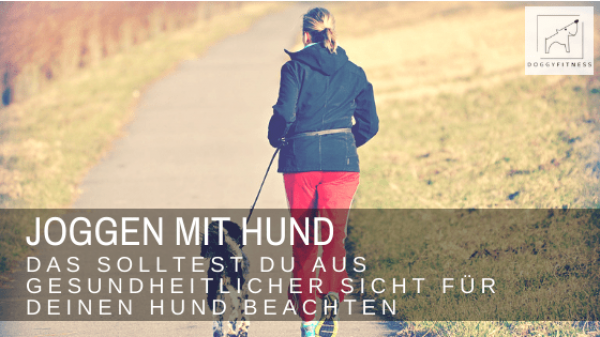Jogging with dog – fitness for man and four-legged friend
Many dogs have great fun accompanying their owner on a jog. They are great endurance runners and the human’s jogging pace means an easy trot for them alongside their human. This gait is great for the dog to build strength and muscle. At the same time he trains his fitness and cardiovascular system.
But what should you keep in mind so that you both enjoy it and your dog stays healthy in the process?
Can any dog jog?
Clearly no. For your dog to accompany you on a jog, he should be fully grown. Otherwise, you risk permanent joint damage. So jogging is taboo for young dogs! If your dog is already older, the movement should also be adapted to his age. Watch him very closely to see if he can still keep up, or if jogging is becoming too strenuous for him. Then the pace should slow down and also adjust the route. After a certain age, you should then switch from jogging to relaxed walks with your dog.
There are also dog breeds whose physique does not make them endurance runners. These include, for example, dogs with a heavy and massive build, such as French bulldogs. Also, severely overweight dogs should not accompany you on your jogging laps, but first lose some weight. Otherwise, the load on the joints is far too high and permanent damage to the joints is inevitable.
How long can a dog run and does it need to be trained?
Just start jogging with your dog- it would be nice! But remember your first jogging laps. That was definitely pretty exhausting and you kept taking breaks and changing tempo. The same goes for your dog. In any case, the training should be built up step by step. Especially after winter break or if you’re new to the sport, start training with short sessions that you build up slowly. Start with a few minutes at a light trot, then switch to walk for a short time before following with the next session at a trot. Your dog must have the opportunity to get fit and build up condition. Don’t overwork an older dog either and always think about the joints. If your dog slows down and switches to walking or pants heavily, you should give him a break or stop training immediately.
Which floor is suitable?
The optimal surface is soft and springy. Asphalt and gravel paths are not good for the joints and especially for dogs with joint diseases, you should make sure that the surface is easy on the joints. If possible, choose forest and field paths for your joint jogging rounds, so the movements are better cushioned.
When is jogging taboo?
Jogging is taboo for your dog if he is severely overweight, he is growing (younger than 12-18 mon.) or very old. Also, if your dog is in pain, he should not be jogging with you. Is your dog in poor health or suffering from an inflammation, infection or fever? Even then, any form of sport is taboo.
Is your dog allowed to eat in front of it?
Please do not feed your dog for at least 2 hours before and in between. Training is not good on a full stomach and the effort for the circulation is much higher. Thus, you are putting your dog at risk when he exercises on a full stomach.
Your dog should also have loosened up before the sport!
And what about drinking in between?
Your dog is allowed to drink before jogging as well as in between. Even a dip in the lake or stream can be a welcome cool down if your dog has had a brief moment to cool down beforehand.
Before you start: Warm up!
At the beginning, you should do some warm-up exercises with him. With the WARM UP you warm up the muscles and joints. You also reduce the risk of injury, because the dog’s body is more elastic after warming up and can handle abrupt movements better. In addition, your dog will also mentally adjust to the training and be more focused. And after your workout, take some time to do some COOL DOWN exercises.
How often can your dog go jogging?
Train with your dog no more than every other day. The body needs time to recover and the muscles only build up during these breaks.
What about jogging in warm temperatures?
Never go jogging with your dog in the heat. This means extreme strain on the cardiovascular system. The asphalt heats up a lot, which can quickly become painful for your dog’s paws. So during the summer months, be sure to take your dog for an early morning or late evening jog. Otherwise, you’re putting your dog in serious health danger.
After jogging:
Continue to watch your dog closely after training and the day after. Are his movements and activity normal? Or does he move sluggishly and is conspicuously still? Dogs can also get painful muscle soreness if they run too fast or for too long. If this happens, you should definitely adjust the training workload.
TIP: By the way, if you want your hands free while jogging, but your dog can’t run freely, there are jogging straps that you attach around your belly.
Have fun on your jogs together!
After sports, your dog will really enjoy some relaxation. A light MASSAGE to loosen up the muscles is just the thing for him and a great ritual for both of you!
Do you have questions about the post or a topic request? Then feel free to write me a comment or a message!
Dieser Beitrag ist auch verfügbar auf:
Français (French)
Deutsch (German)
Español (Spanish)















